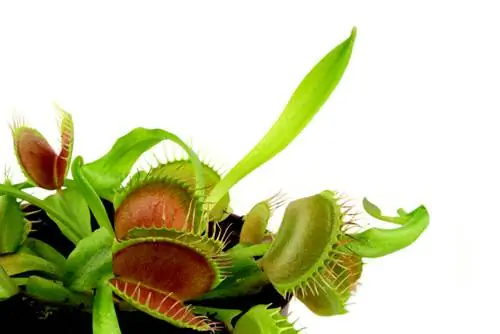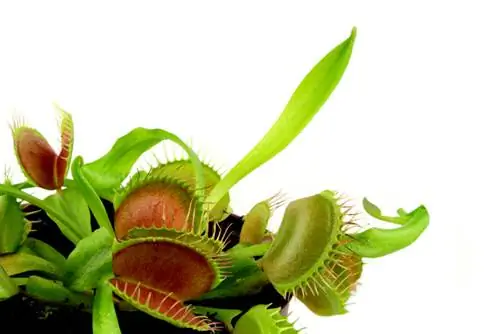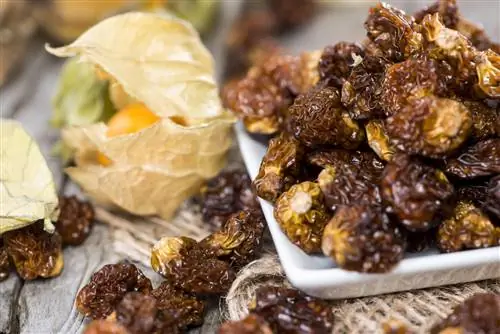- Author admin [email protected].
- Public 2023-12-16 16:46.
- Last modified 2025-01-23 11:20.
For beginners, the Venus flytrap is not necessarily the easiest carnivorous plant. There are a few things to consider when keeping the carnivore if you want the carnivore to thrive. Watering in particular requires a lot of sensitivity. Tips for proper care of Venus flytraps.

How do you properly care for a Venus flytrap?
Proper care for a Venus flytrap includes watering with rainwater using the stagnation method, a humidity of 40-55%, no fertilizer, no regular feeding, removing dried traps and inflorescences if necessary, and regular repotting.
How do you water Venus flytraps correctly?
Venus fly traps thrive best in the damming process. The pot is provided with drainage at the bottom and placed in a saucer. Pour enough water onto the substrate until the saucer fills an inch or two high with liquid.
If the water from the saucer has evaporated or been absorbed, wait two days and then water again.
Use only rainwater for watering. Carnivores cannot tolerate anything containing calcium at all. Alternatively, you can also use distilled water or still mineral water for watering.
What humidity is ideal?
The ideal humidity is between 40 and 55 percent. In summer you can spray the plant. During the winter it is ideal to keep the Venus flytrap in a terrarium or display case.
Do Venus flytraps need fertilizer?
You should never fertilize Venus flytraps, even if it is often advised to do so. The substrate usually already contains more nutrients than the plant needs. If there are too many nutrients, the Venus flytrap will die.
Do you need to feed the carnivorous plants?
Feeding is not necessary. The plant is adequately supplied by the substrate and the nutrient stores in the leaves, even if there are no insects present.
You are of course allowed to feed the carnivorous plant occasionally, just because it is very interesting to watch. Then only give a few living insects that are a maximum of a third as large as the trap itself. Under no circumstances should you feed them food leftovers.
Are Venus flytraps cut?
The dry traps are only removed when they are completely dry.
However, it can make sense to cut the inflorescences immediately after they sprout. The formation of flowers deprives the plant of the strength it needs to grow new traps.
When do the plants need to be repotted?
Venus fly traps should be repotted every spring. The plant grows quite quickly and forms many rhizomes, so the pot soon becomes too small.
Remove dead root residue before repotting. Now is also the best time to obtain offshoots. To do this, simply tear the plant apart so that enough leaves and roots remain on each section.
Remove the old substrate and place the Venus flytrap in fresh substrate. Then water the plant well.
What diseases and pests occur?
Illnesses hardly occur. If the plant dies, there are almost always care errors.
Some pests can attack the Venus flytrap:
- Thrips
- Aphids
- Sickness Gnat Larvae
Check the plant regularly for pest infestations and take immediate control measures.
Why do the leaves suddenly turn black?
The long-stemmed leaves that grew in summer turn black in winter. This is a normal process and not a sign of illness.
Why do the traps die?
The Venus flytrap's folding trap only has a limited lifespan. It opens a maximum of seven times. Then she dies. If it dries up earlier, it may be because a digested insect was too large.
It is a normal process that the traps become smaller and smaller towards winter. This heralds the start of winter rest for the plant.
Can you put Venus fly traps outside in summer?
Basically, there is nothing wrong with treating your plants to a summer holiday in the fresh air. The prerequisite is that a location that is as sunny as possible but not as draughty is chosen.
The temperatures should be as consistent as possible; the Venus flytrap cannot tolerate strong fluctuations.
Before you put the plants outside, slowly get them used to the new location. Direct sunlight should be avoided for the first few days. Then increase the time in direct sun by the hour.
How is the Venus flytrap properly overwintered?
Venus flytraps are not hardy. Temperatures should never fall below 5 degrees. However, the plant needs to be cooler in winter than in summer. Ambient temperatures should be between 5 and 12 degrees. In winter, do not place the Venus flytrap directly in the sun and avoid drafts.
In winter the plant needs less moisture than in summer. Therefore, water less often; once a month is usually enough. But never let the substrate dry out completely, as the plant will then die.
The Venus flytrap almost stops growing in winter. Only a few small traps grow even in the cold season.
Tip
The Venus flytrap belongs to the sundew family. It only occurs naturally in a very limited area in the United States. In local regions, the carnivorous plant is cultivated exclusively as a houseplant.






